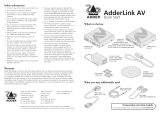
15
Other products in the X-Series range
The following related X-Series items are also available:
• Gold Extender (part code: X-KVMAS)
This pair of modules allow you to extend not only keyboard, video and
mouse signals up to 200 metres, but also similarly support microphone,
stereo speaker and an RS232 serial channel.
• Dual video transmitter (part code: X-DVT)
Allows one system to be controlled from two locations or permits a second
video channel to be sent to a remote location. Used in conjunction with two
standard receiver/remote modules.
• Remote receiver module (part code: X-KVM/R)
Two of these are required, one at the end of both remote cable spurs
emanating from the Dual Video Transmitter. These modules convert the
coded signals from the Dual Video Transmitter back into native formats used
by keyboards, video monitors and mice.
• Skew compensator (part code: X-SC)
Removes colour split in video signals caused by certain Cat 5e and 6 cables.
Required only in certain installations with long cable lengths and high video
resolutions.
• Rack mount chassis (part code: RMK-CHASSIS)
This 19” chassis allows multiple X-Series modules to be neatly arranged
within a standard cabinet. Securing plates and screws are supplied separately
for each X-Series module for use with the rack mount chassis.
• Power distribution module (part code: X-PDM4)
Provides power for up to four X-Series modules to reduce mains power
socket requirements.
• Rack mount securing plates
• for USB Extender (part code: X-RMK-USB)
• for Gold Extender remote module (part code: X-RMK-KVMAS/R)
• for Gold Extender local module (part code: X-RMK-KVMAS/T)
• for Dual Video Transmitter (part code: X-RMK-DVT)
• for Skew compensator (part code: X-RMK-SC)
• single slot blanking plate (part code: X-RMK-BLANK)
• quad slot blanking plate (part code: X-RMK-BLANK4)
Safety information
• For use in dry, oil free indoor environments only.
• Do not use to link between buildings.
• Ensure that the twisted pair interconnect cable is installed in compliance
with all applicable wiring regulations.
• Do not connect the CATx link interface (RJ45 style connector) to any other
equipment, particularly network or telecommunications equipment.
• Warning – the power adapter contains live parts.
• No user serviceable parts are contained within the power adapter - do not
dismantle.
• Plug the power adapter into a socket outlet close to the AdderLink unit that
it is powering.
• Replace the power adapter with a manufacturer approved type only.
• Do not use the power adapter if the power adapter case becomes damaged,
cracked or broken or if you suspect that it is not operating properly.
• If you use a power extension cord with the AdderLink, make sure the total
ampere rating of the devices plugged into the extension cord do not exceed
the cord’s ampere rating. Also, make sure that the total ampere rating of all
the devices plugged into the wall outlet does not exceed the wall outlet’s
ampere rating.
• Do not attempt to service the AdderLink yourself.
• The AdderLink units and power supplies can get warm in operation – do not
situate them in an enclosed space without any ventilation.
• The AdderLink does not provide ground isolation and should not be used for
any applications that require ground isolation or galvanic isolation.
Warranty
Adder Technology Ltd warrants that this product shall be free from defects in
workmanship and materials for a period of two years from the date of original
purchase. If the product should fail to operate correctly in normal use during the
warranty period, Adder will replace or repair it free of charge. No liability can be
accepted for damage due to misuse or circumstances outside Adder’s control.
Also Adder will not be responsible for any loss, damage or injury arising directly
or indirectly from the use of this product. Adder’s total liability under the terms
of this warranty shall in all circumstances be limited to the replacement value
of this product. If any difculty is experienced in the installation or use of this
product that you are unable to resolve, please contact your supplier.




















